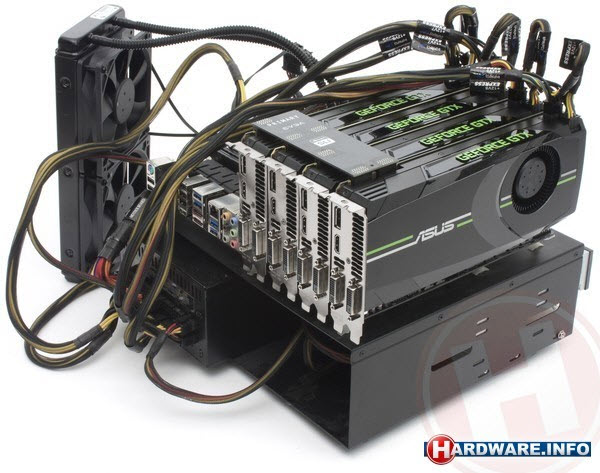NVIDIA GeForce GTX 680 in quad-SLI configuration benchmarked

This is both insane and impressive - four GeForce GTX 680 cards fitted in a quad-SLI configuration, benchmarked for our pleasure!
Dutch website Hardware.info managed to get four of NVIDIA's new GPUs and decided to see what would happen if they were all fitted into a single machine. What happened was that the system blew away the current benchmarks.
See also: Hardware 2.0 'Very Best Kit List' for February 2012
The system scored an impressive 21,107 in the 3DMark11 benchmark test, comfortably beating the quad-Crossfire AMD Radeon HD 7970, which scored 20,853, and also aced the 3DMark11 Extreme test with 10,850, once again beating the quad-Crossfire AMD Radeon HD 7970, which only managed a score of 9,989.
Can the rig run Crysis 2? You bet it can run Crysis 2! It managed 99.8 frames per second with Crysis 2 running DirectX 11 at hi-res anti-aliasing and at a screen resolution of 1920x1080. What's interesting is that the current drivers don't seem to scale very well since a single GTX 680 managed 98.9 frames per second. I expect that this will be fixed in future driver updates from NVIDIA.
It plays Skyrim a lot better. Two GTX 680s ran the game at 92.8 frames per second running on three screens at 5750x1080, beating the quad-Crossfire AMD Radeon HD 7970, which only managed 91 frames per second.
There is a downside though - power consumption. Even with the system at idle, Two GTX 680s consumed 114.5 Watts, far more than three Radeon HD 7970s that only pulled 99 Watts. Push the system hard and you can expect two GTX 680s in an SLI configuration to pull a whopping 475 Watts. You'd better have a really good, really stable power supply unit.
If you're looking for power, then this is the sort of setup that should appeal to you, but at over $2,000 for the graphics cards alone, you will need to dig deep!
Related:
- Microsoft says no new Xbox 'anytime soon'
- AMD owns up to CPU bug
- Windows 8 Consumer Preview: Are your applications and devices compatible?
- Wouldn't a Valve 'Steam Box' console be nothing more than a PC?
- AMD launches two new HD 7800 series GPUs
